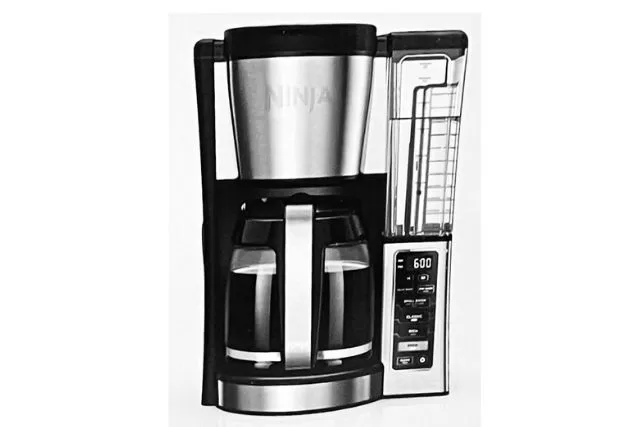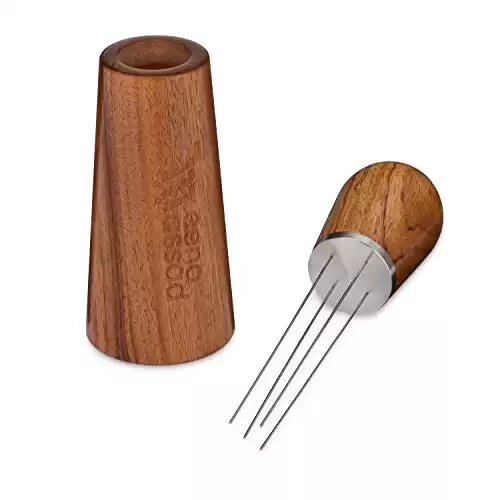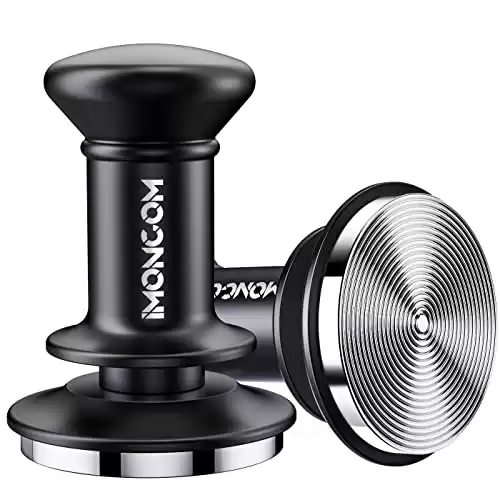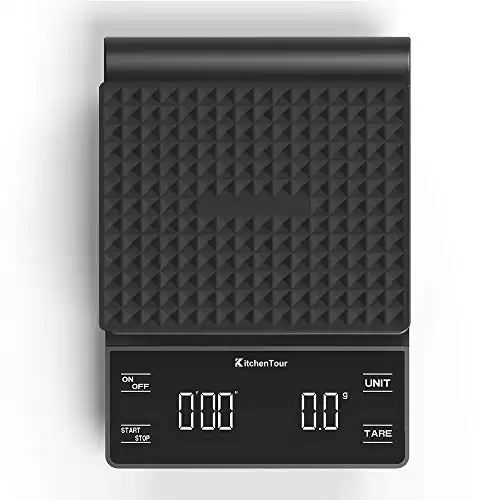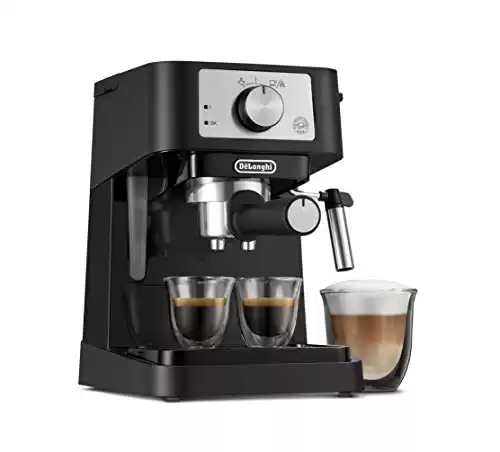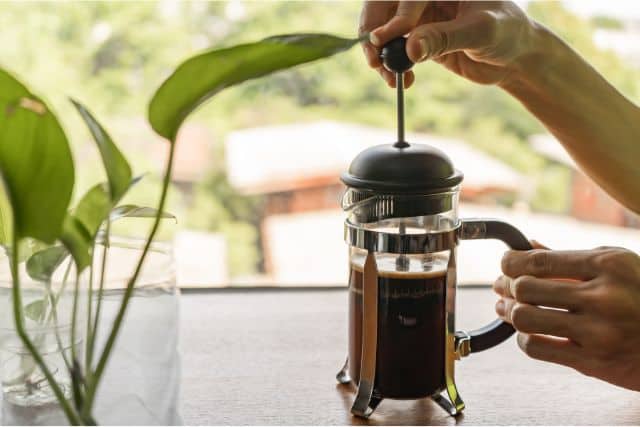How To Tamp Espresso To Get The Most Consistent Taste
This post contains affiliate links, which means we receive a small commission on qualifying purchases. This does not impact your cost in any way. See details here.

Knowing how to tamp espresso properly is a crucial step in the espresso-making process that involves applying pressure to the ground coffee in the portafilter to create a compact, even puck. This ensures that hot water is forced through the grounds evenly, resulting in a consistent and balanced espresso shot.
Tamping espresso is necessary for achieving a perfect espresso, and it requires the use of specific tools and techniques.
The tools needed for tamping espresso include:
- an espresso tamper, an espresso machine, a measuring scale, and a timer.
The espresso tamper is a handheld device used to apply pressure to the coffee grounds. The espresso machine is used to extract the espresso shot and should have a good pressure gauge for accurate tamping. A measuring scale and timer are important for consistency in measuring and timing the tamping process.
To tamp espresso correctly, follow these steps:
- Grind the beans to the appropriate size for espresso.
- Distribute the ground coffee evenly in the portafilter.
- Apply pressure with the tamper to create a compact puck.
- Check for uniformity in the puck and adjust if necessary.
Factors that can affect tamping include:
- the quality and type of coffee beans,
- the size of the grind,
- the pressure applied while tamping, and
- the technique used.
Common mistakes in tamping espresso include:
- inconsistent pressure,
- uneven distribution of ground coffee,
- incorrect tamping technique, and
- using the wrong tamper size.
These mistakes can result in an inconsistent and unbalanced espresso shot.
If you are experiencing inconsistent tasting espresso, you can troubleshoot by:
- adjusting tamping pressure,
- changing the grind size,
- trying different tamping techniques, and
- using a different tamper size.
With practice and proper technique, tamping espresso can lead to a consistently flavorful and perfect espresso shot every time.
What Is Tamping Espresso?
Tamping espresso is the process of firmly pressing the coffee grounds in the portafilter to create a uniform surface, optimizing the extraction process. This ensures a consistent and balanced taste in the espresso shot. The pressure applied during tamping is crucial for achieving the desired brew, as it influences the flow rate and the overall quality of the espresso.
So, what exactly is tamping espresso? It is the act of pressing the coffee grounds firmly in the portafilter, which is essential for creating a uniform surface and ensuring a consistent and balanced taste in the espresso shot. The pressure applied during tamping plays a crucial role in achieving the desired brew, as it directly affects the flow rate and the overall quality of the espresso.
Why Is Tamping Espresso Important?
Knowing how to tamp espresso is crucial for ensuring an even extraction, preventing channeling, and ultimately achieving a balanced, flavorful shot. Proper tamping helps create a uniform surface, allowing water to flow through the coffee evenly, resulting in a more consistent taste.
So, why is tamping espresso important?
Pro-tip: When tamping, apply approximately 30 pounds of pressure to the coffee grounds using a calibrated tamper to achieve optimal extraction.
What Are The Tools Needed For Tamping Espresso?
In order to achieve a consistent and delicious shot, knowing how to tamp espresso is a crucial technique. But what tools are needed for this process? In this section, we will discuss the essential tools needed for tamping espresso: an espresso tamper, an espresso machine, a measuring scale, and a timer. Each of these tools plays a crucial role in ensuring the perfect tamp for a consistent and balanced taste in your espresso shots. Let’s dive in and explore each one in more detail.
1. Espresso Tamper
- Select the appropriate size of an espresso tamper for your portafilter.
- Position the portafilter on a flat and sturdy surface.
- Evenly distribute the ground coffee into the portafilter.
- Using approximately 30 pounds of pressure, press down evenly on the coffee grounds with the tamper handle.
- To ensure a level and smooth surface, gently twist the tamper on the top of the coffee puck.
2. Espresso Machine
- Choose the best espresso machine for your needs: Consider whether a manual, semi-automatic, or super-automatic machine is right for you.
- Examine the features: Decide if you want a machine with added features such as built-in grinders or milk frothers.
- Consider the size: Make sure the machine fits in your space and complements your kitchen decor.
- Verify the warranty and customer service: Opt for a machine with a reliable warranty and customer service for any troubleshooting needs.
Fun Fact: The first espresso machine was invented in 1884 by Angelo Moriondo of Turin, Italy.
3. Measuring Scale
- Place the portafilter on the measuring scale.
- Tare the scale to zero.
- Add the desired amount of coffee grounds into the portafilter.
- Check the weight displayed on the scale to ensure it matches the targeted dose.
- Adjust the amount of coffee grounds as needed to achieve the precise measurement.
4. Timer
- Set the timer to track the espresso shot extraction time.
- Start the timer as soon as you begin the espresso extraction process.
- Monitor the time to ensure the shot falls within the recommended time frame, typically 25-30 seconds.
For best results, use a digital timer with an audible alarm to signal when the extraction is complete.
How To Tamp Espresso Correctly?
Tamping is a crucial step in the espresso-making process that can greatly impact the taste and quality of your espresso. But how do you properly tamp your espresso for the most consistent taste? In this section, we will break down the steps involved in tamping and provide tips for achieving the perfect tamp. From grinding the beans to checking for uniformity, we will cover all the essential elements for tamping espresso like a pro.
1. Grind The Beans
- Ensure you have the right grind size for your espresso machine.
- Measure the appropriate amount of coffee beans for your espresso shot.
- Grind the coffee beans to the correct coarseness, resembling table salt.
- Check the consistency of the ground coffee for an even extraction.
2. Distribute The Ground Coffee Evenly
- After grinding the coffee beans, distribute the ground coffee evenly in the portafilter.
- Use a distributing tool or your fingers to evenly spread the coffee across the portafilter.
- Ensure there are no clumps or uneven areas to achieve a uniform density.
Tamping espresso dates back to the 1940s when Italian coffee culture and the love for espresso started to flourish. This led to the development of various tools and techniques for evenly distributing the ground coffee in the portafilter.
3. Apply Pressure With The Tamper
- Position the tamper directly over the portafilter with your elbow positioned directly above the tamper.
- Apply pressure evenly with your body weight, aiming for about 30 pounds of pressure.
- Keep the tamper level and avoid twisting while applying pressure to ensure an even and uniform tamp.
4. Check For Uniformity
- After tamping, examine the surface of the coffee puck for uniformity.
- Make sure the entire puck has a level and smooth surface.
- Look for any irregularities or inconsistencies in the tamped coffee.
Fact: Ensuring uniformity in tamping espresso is crucial for achieving an even extraction and balanced flavor profile in the final coffee.
What Are The Factors That Affect Tamping Espresso?
You’ve heard us say it reputedly in this post, but knowing how to tamp espresso properly is a crucial step in making a delicious and consistent cup of espresso.
However, there are several factors that can affect the tamping process and ultimately the taste of your espresso. In this section, we will explore these factors in depth and discuss how each one can impact the final result.
From the type of coffee beans to the tamping pressure and technique, we’ll uncover the key elements that play a role in creating the perfect espresso shot.
1. Coffee Beans
- Choose high-quality coffee beans, such as Arabica or Robusta, renowned for their rich flavor and aroma.
- Consider the origin of the beans, as it greatly affects the taste profile. For example, Ethiopian beans offer fruity and floral notes.
- Opt for freshly roasted beans to maximize flavor and complexity.
- Experiment with different roast levels to find the perfect flavor for your espresso.
When selecting coffee beans, prioritize freshness, origin, and quality to enhance your espresso experience.
2. Grind Size
- Select the appropriate grind size for your espresso machine, taking into account that a fine grind, similar to table salt, is ideal for proper extraction when brewing espresso.
- Adjust the grind size according to the machine’s brewing time and resistance, aiming for an extraction time of 25-30 seconds.
- Maintain consistency in the grind size to avoid over-extraction (fine grind) or under-extraction (coarse grind), which can greatly affect the flavor and quality of the espresso.
3. Tamping Pressure
- Ensure the portafilter is secure on a flat surface.
- Place the tamper on the coffee grounds and apply 30 pounds of pressure.
- Polish the grounds by twisting the tamper gently.
- Check for a level and smooth coffee surface.
Pro-tip: Consistent tamping pressure is crucial for balanced extraction, resulting in a flavorsome espresso shot. Remember to apply 30 pounds of pressure when tamping for the best results.
4. Tamping Technique
- Ensure the portafilter is securely placed on a flat surface.
- Place the tamper on the coffee grounds and evenly press down with approximately 30 pounds of pressure.
- Polish the grounds by twisting the tamper after pressing.
- Check for a level and uniform surface after using the tamping technique.
What Are The Common Mistakes In Tamping Espresso?
Even the most experienced baristas can make mistakes when tamping.
In this section, we will discuss the most common mistakes that can occur during tamping and how they can affect the consistency of your espresso. From inconsistent tamping pressure to using the wrong tamper size, we’ll cover each mistake and its potential consequences.
1. Inconsistent Tamping Pressure
- Check pressure: Utilize a calibrated tamper to ensure consistent pressure with each tamp.
- Practice: Train baristas to develop a muscle memory for consistent tamping.
- Evaluate equipment: Regularly assess espresso machines and tampers for consistent performance.
- Adjust technique: Experiment with different tamping methods to find the most consistent approach for addressing inconsistent tamping pressure.
2. Uneven Distribution Of Ground Coffee
- Ensure an even surface by leveling the portafilter basket.
- Evenly distribute the ground coffee using a distribution tool.
- Break up any clumps and create a level coffee bed by rotating the distribution tool.
Pro-tip: Consistent distribution of ground coffee is crucial for balanced extraction and a flavorful espresso shot. Experiment with different distribution techniques to find the one that works best for your coffee and espresso machine.
3. Incorrect Tamping Technique
- Incorrect hand positioning: Placing the hand too high or too low on the tamper can lead to uneven tamping.
- Inadequate pressure: Applying too little or too much pressure can result in an uneven extraction.
- Uneven distribution: Failing to distribute the coffee grounds evenly in the portafilter can lead to channeling and an uneven extraction.
- Incorrect angle: Tamping at an angle can cause uneven density in the puck.
To avoid these issues, ensure consistent hand positioning, apply uniform pressure, distribute grounds evenly, and tamp vertically to achieve a well-extracted espresso. Additionally, it is important to avoid incorrect tamping techniques, such as placing the hand in the wrong position or tamping at an angle.
4. Using The Wrong Tamper Size
- Check the size of the espresso machine’s portafilter to determine the appropriate tamper size.
- Make sure the tamper’s diameter matches the size of the portafilter for proper tamping.
- Using a tamper that is too small can result in inadequate pressure and inconsistent extraction.
- If the tamper is too large, it may not fit into the portafilter, causing uneven tamping.
How To Troubleshoot Inconsistent Tasting Espresso?
As any coffee connoisseur knows, making the perfect espresso is both an art and a science. However, even with the right equipment and technique, inconsistencies in taste can still occur.
In this section, we will explore the common issues that can lead to inconsistent tasting espresso and how to troubleshoot them.
From adjusting the grind size to finding the right tamping pressure, we will cover the various methods to achieve a consistent and delicious espresso experience.
1. Adjusting
- Assess the taste: Identify the specific flavors that are overpowering or lacking in the espresso.
- Adjust the grind size: Finer grind for sour taste, coarser for bitter taste.
- Modifying the tamping pressure: Increase for sour taste, decrease for bitter taste.
- Checking the machine: Ensure the espresso machine is functioning properly.

Frequently Asked Questions
What is tamping and why is it necessary for making espresso?
Tamping is the process of compressing coffee grinds in the portafilter to create a level, compressed puck. This allows for even extraction of the espresso and prevents the water from taking shortcuts and resulting in unevenly dense and poorly distributed shots. Tamping is necessary because of the high pressure involved in the espresso-making process, without which the resulting shots would be imbalanced and unpleasant.
What is the recommended pressure for tamping?
The recommended pressure for tamping is 30 pounds, but consistency is more important than the exact amount of pressure used. As long as the grinds are evenly distributed and compacted, the resulting pressure will be sufficient for optimal extraction.
How do I achieve level tamping?
To achieve level tamping, a flat tamper and a perfectly horizontal tamping technique are essential. You can also use a tamping mat or tap the portafilter against a tamping mat as a quick trick to evenly distribute the grounds before tamping. Alternatively, you can invest in a bottomless portafilter or use the Lyn Weber Stock Tamper that has a convex RB to ensure a level tamp.
Can tamping lead to repetitive strain injuries?
Yes, repetitive tamping with a traditional tamper can lead to wrist injuries. To avoid this, you can use a Pro Barista’s Tamping Mat or invest in a portafilter cradle that allows for a more ergonomic tamping position. You can also use dosing cups or a La Cimbali Max Hybrid that has a vertical axis to reduce strain on your wrist.

